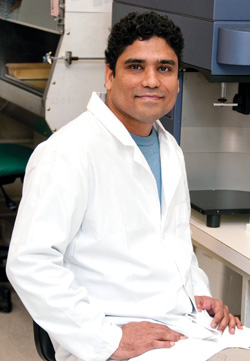News
In Conversation:
Research Fellow Ram Savan, Ph.D.

Ram Savan, Ph.D. (Photo: J. Sommers, SPGM, NCI-Frederick)
CCR: Congratulations, Ram, on receiving the Milstein Young Investigator Award from The International Society for Interferon and Cytokine Research last year. We understand that the award honors scientists who have made an impact on interferon or cytokine research early in their careers. Could you tell us about your research?
Ram: I work with Howard Young, Ph.D., Deputy Chief of the Laboratory of Experimental Immunology. The award was for work related to the regulation of INF-γ, which is a focus in our laboratory. We’ve long known that the mRNA for INF-γ is rapidly degraded, almost as fast as it is made. We discovered a microRNA—miR-29 that actually stabilizes the mRNA transcript. From our experiments, we believe that mir-29 binds to the mRNA recruiting a complex that restricts the access of RNA degrading machinery.
CCR: But, aren’t most microRNAs thought to actually help destroy, rather than preserve, gene transcripts?
Ram: Exactly. MicroRNAs recruit RISC complexes. RISC stands for “RNA-induced silencing complex.” When we first observed this microRNA region near the INF-γ gene, we thought it would enhance degradation of the transcript. Imagine our surprise when we added miR-29 and saw more INF-γ than before. We did a lot of different experiments to convince ourselves (and others!) that this was real.
CCR: So, you have been working on this project during your 4 years at CCR?
Ram: Yes, but also on two completely different projects. One, which has just been published in Nature, identifies a microRNA-binding regulatory element in the HLA-C gene that influences levels of HLA-C allotype cell surface expression, affecting the immune response to HIV. This project was in collaboration with Smita Kulkarni, Ph.D., and Mary Carrington, Ph.D. The other project looks at a new role for the IL-22 receptor in inflammation, which could be important for certain lymphomas.
CCR: Those are some very diverse projects. How have you done it all?
Ram: Through collaborations, no question. We are part of the Cancer and Inflammation Program, headed by Giorgio Trinchieri, M.D., and it is the most collaborative scientific environment I have ever experienced. It combines two laboratories—ours and the Laboratory of Molecular Immunoregulation— including 15 Principal Investigators. Everyone is incredibly open about their data and keen to help.CCR: What are your plans for the future?
Ram: I am looking for a faculty position and to run my own laboratory. I want to take what I’ve learned here about microRNAs and focus my own lab on post-transcriptional regulation. There are so many intricacies to decipher; it’s immensely complex. I really want to study the role of post-transcriptional regulation under infectious conditions, like in chronic HIV patients.
CCR: We wish you great success in your work. Do you have any advice for aspiring Fellows?
Ram: My advice? Always have a back- up project. For the first couple of years that we were unraveling our paradoxical miR-29 results, I had a very hard time. I was learning a new technology and getting unexpected readouts; it was very confusing. So, I created back-up projects and then got very lucky. You don’t want to end up with nothing when a risky project goes wrong.











